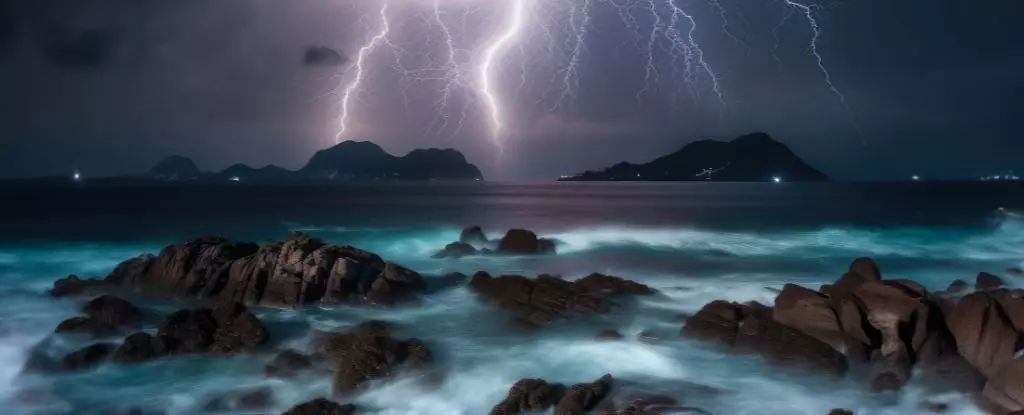Research from Stanford University is inviting us to reconsider our understanding of life’s beginnings. In a world that has traditionally seen lightning strikes as the heralds of the miraculous chemistries supporting life, a more delicate—and arguably more poetic—explanation is emerging. The idea of ‘microlightning’ posits that life’s building blocks were more likely to emerge from the soft caress of ocean mists rather than the violent arcs of lightning. This research, led by chemist Richard Zare, is changing the narrative on the sources of organic compounds—a change that could have profound implications for our understanding of biogenesis.
The conventional Miller-Urey experiment has long been the cornerstone of theories explaining the origins of life. Stanley Miller’s groundbreaking work in 1952 demonstrated how basic elements, when subjected to electrical sparks, could yield amino acids—the vital components of life as we know it. However, the Miller-Urey model has faced scrutiny over its applicability to the Earth’s primordial conditions. It has always felt like a clunky theory, struggling to represent an elegantly complex and beautifully chaotic process. Enter ‘microlightning,’ which not only proposes a new mechanism but also whispers of a more harmonious synthesis of life’s fundamental ingredients through gentle energy exchanges rather than cataclysmic forces.
The Power of Small Forces in a Large Universe
Zare’s research emphasizes the potential energy and chemical outcomes associated with water microdroplets—simply remarkable. High-speed imaging of these droplets revealed a dazzling display of ‘photons’ emitted during electron exchanges, indicating that the seemingly mundane activity of small water droplets has the power to catalyze complex organic chemistry. It’s a refreshing take that encourages optimism when considering life’s potential elsewhere. If this phenomenon occurs universally wherever conditions mimic early Earth—many scientists would argue that habitats for life may be more widespread than we realize.
This research doesn’t just suggest alternative pathways for creating amino acids and nucleic acids like uracil and glycine. It also broadens the scope of debate regarding how life’s precursors might arise. While traditional theories have leaned heavily on the violent interactions of planetary atmospheres, this new consideration of milder forces offers a compelling counter-narrative. It paints a picture of a universe brimming with possibility; rather than visualizing peak energy release as the only key to chemical evolution, we can now appreciate the subtle yet dynamic interplay of small forces.
The Experiment that Could Transform Scientific Understanding
The experiments conducted by Zare and his team are a notable advancement in understanding the synthesis of life’s building blocks. The method they have adopted—spraying mist into a mix of gases to stimulate chemical reactions—stirs visions of oceans swirling with diverse ingredients, creating a primordial soup. The implication that even weak electric discharges between these tiny droplets could forge complex organic compounds is profoundly significant, scrutinizing the old paradigm while advancing into unexplored territories.
But isn’t it also an unsettling trend to consider that the certainties we’ve held dear, such as lightning as the primal force for life, may falter against the backdrop of this more nuanced approach? The rise of microlightning suggests that—much like life itself—the mysteries surrounding its inception might not come from spectacular cataclysms, but rather from the gentle stirrings of nature, where chemistry coalesces in unexpected ways.
Broader Implications for the Search for Life in the Cosmos
If ‘microlightning’ is indeed a viable process for the formation of organic compounds, what does it mean for astrobiology? It transforms our search for extraterrestrial life by suggesting that countless celestial bodies with water and gaseous atmospheres should not be overlooked. The idea that life can thrive wherever gentle mists mix with life-sustaining gases is an empowering thought.
Imagine other worlds, not unlike early Earth, where water vapor—a seemingly common substance in our universe—interacts with simple gases to create organic compounds. The elegance of Zare’s findings opens a Pandora’s box of possibilities about the innate resilience of chemistry and life. As the universe expands, these newfound insights might guide astrobiologists in their quest, making the cosmos feel less mysterious and more like a vast field ripe with opportunities for discovery.
This shift in perspective—as stark as it is inspiring—invites a reflection on our role in the unfolding narrative of life’s origins. Instead of fearing the chaos of lightning, we might embrace the harmony of microlightning, ensuring that the seeds of existence are sown through small acts of cosmic kindness. The story of life may not be the one we thought we knew; perhaps instead, it is far more enchanting than we ever imagined.


Leave a Reply